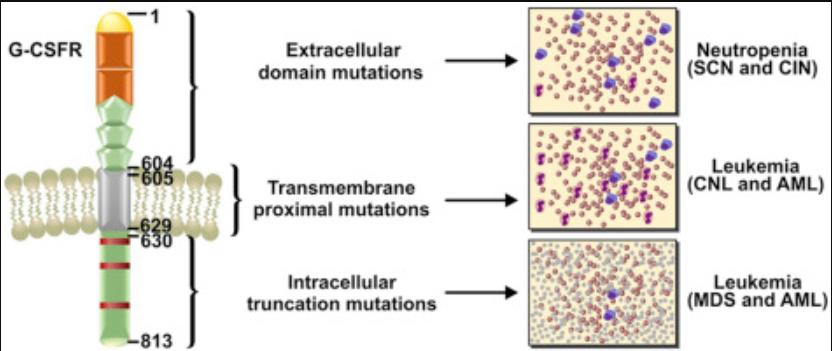What is CSF3R Protein?
The CSF3R protein, which stands for that Colony Stimulating Factor 3 Receptor, is a protein-encoded gene that plays a considerable role in hematopoiesis. The understanding and examination of CSF3R protein have enhanced our comprehension of numerous biological systems and the pathogenesis of related diseases.
Discovery and Background
The CSF3R gene, scientifically named the granulocyte colony-stimulating factor receptor gene, was initially identified and mapped to the distal short arm of chromosome 1 at band 1p35-p34.3 in 1991. It occupied an essential place in the scientific community due to its indispensable role in the regulation of neutrophils, a significant component of the immune system.
Gene Locus & Protein Structure
Found on the chromosome 1, the CSF3R gene locus is positioned specifically at 1p34.3. The gene spans around 60 kilobases and comprises of 17 exons. The CSF3R protein is encoded by this gene and consists of 813 amino acids, which form a multi-domain structure. The protein encompasses an extracellular region, a single-span transmembrane region and a cytoplasmic region, which consists of two crucial motifs - the box 1 and box 2 motifs. These motifs largely contribute to CSF3R protein's functionality, particularly in activating downstream signaling pathways.
Function of CSF3R Protein
The CSF3R protein is a crucial component in the human body because it functions as the primary receptor for granulocyte colony-stimulating factor (G-CSF). This suggests its indispensable role in granulopoiesis, contributing to the proper functioning and proliferation of neutrophilic granulocyte lineage. Moreover, CSF3R protein mediates several biological responses, including cell survival, proliferation, differentiation, and functional activation.
CSF3R Protein Related Signal Pathway
Several important signal transduction pathways get activated by the binding of G-CSF to the CSF3R receptor, most noteworthy among which are the JAK/STAT, Ras/MAPK, and PI3K/Akt pathways. These pathways contribute to varying biological effects including differentiation, proliferation, maturation, and survival of cells. In particular, the JAK/STAT pathway plays a crucial role in mediating the transcription of genes related to cell survival and proliferation.
CSF3R Protein Related Diseases
Abnormalities and mutations in the CSF3R protein have been associated with severe congenital neutropenia (SCN), cyclic neutropenia (CN), and chronic neutrophilic leukemia (CNL). The most common of these, SCN, is characterized by a severe decrease in the number of circulating neutrophils, leading to high vulnerability to recurrent infections. CNL, on the other hand, is a myeloproliferative disorder characterized by increased numbers of neutrophils. Over the past decade, mutations in CSF3R have been identified as one of the most common alterations in patients with CNL and atypical chronic myeloid leukemia (aCML).

CSF3R Protein's Applications in Biomedical
The CSF3R protein has extensive applications in the biomedical field, particular in diagnostics and therapeutics. As the identification of CSF3R mutations have been associated with certain myeloid malignancies, testing for such mutations can provide crucial diagnostic information as well as inform treatment strategies.
Research is also being conducted towards developing molecularly targeted therapies to exploit the CSF3R pathway, particularly aiming at JAK/STAT inhibition in patients with CSF3R-mutant CNL. Such therapies may offer new hope for patients with these often aggressive and hard-to-treat diseases.
In conclusion, the CSF3R protein, due to its critical involvement in the growth and stimulation of granulocytes, holds significant biomedical importance. The increased understanding of its structure, function and how it contributes to the development and propagation of diseases continues to offer promising avenues to disease diagnosis and therapeutic intervention. Nonetheless, it calls for further investigation to unlock the enigma around its mechanisms and maximize its prospective benefits in the biomedical sphere.
Our Featured Products
| Cat.No. | Product Name | Species | Source (Host) | Tag |
|---|---|---|---|---|
| CSF3R-1975H | Recombinant Human CSF3R Protein, GST-tagged | Human | Wheat Germ | GST |
| CSF3R-8526H | Recombinant Human CSF3R protein, His-tagged | Human | HEK293 | His |
| CSF3R-2171HF | Recombinant Full Length Human CSF3R Protein | Human | In Vitro Cell Free System | |
| Csf3r-7009M | Recombinant Mouse Csf3r protein, His-tagged | Mouse | E.coli | His |
| CSF3R-4241R | Recombinant Rat CSF3R protein, His-tagged | Rat | E.coli | His |
Reference
- Dwivedi, P., & Greis, K. D. (2017). Granulocyte colony-stimulating factor receptor signaling in severe congenital neutropenia, chronic neutrophilic leukemia, and related malignancies. Experimental Hematology, 46, 9-20. https://doi.org/10.1016/j.exphem.2016.10.008

